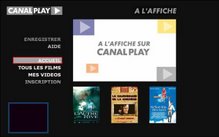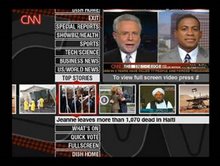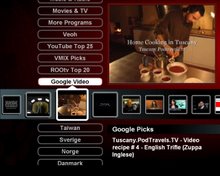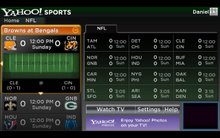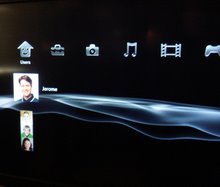Navigate YouTube available at iTunes App Sore
Browse video Standard Feeds, Categories, Channels and Playlists. Then organize new videos into your own favorites and playlists. Make playlists private or public. Subscribe to other user's playlists and video collections for future viewing. Subscribe to videos matching search-words.
Search for new videos tagged for your language or geographical region, using local keyboard. Explore for new videos via easy switching of user ID to the owner of interesting videos - then explore their world.
All actions are kept in sync with PC, Mac or Apple-TV access to YouTube. Available at Apple App Store.
active-TV technology for PC

Windows PC based home network
Monday, August 21, 2006
PC-resident TV-web developer interview
Active-TV uses PC-resident TV-web developed by www.scendix.com. Additionally, Scendix supply broad-band accessed TV-web, such as: mcePhone (Skype-for-TV), the popular mceWeather and mceAuction. This last one, enables access to eBay auction via the TV. McePhone supports use of PC-based Skype from the living room TV.
Scendix’s Christioph Buenger was interviewed at the Las Vegas eBay Developer Conference. The interviewer uses Microsoft-speak and talks about “MCE solutions”; These “solutions” are TV-web and active-TV makes them available on more than just the Media Center Edition PC – specifically, the active-TV enabled hybrid-STB.
Please see a video of the interview at http://www.on10.net/Blogs/TheShow/4960/. Christoph demonstrates mceAuction but also talks about his other broadband TV-web applications.
Feedback, corrections and comments welcome.
Wednesday, August 16, 2006
Should TV-web be formated with HTML, MCML, WinFX or CE-HTML ?
Active-TV Ecosystem Developers,
The Wall Street Journal [WSJ] reports that the "TV Portal Service Corp" has been formed by a Japanese consortium to develop a common standard for TV-web. A specification is expected in spring 2007. It is likely that the standard depends on a reduced-sized browser-engine, or micro-browser. The browser would support a reduced HTML format; know as CE-HTML (Consumer Equipment), or sometimes c.HTML (Compact HTML), or more recently Web-4-CE.
- [WSJ] Sony, Panasonic, Sharp, Toshiba and Hitachi are understood to be developing a joint Japanese standard for internet-connected televisions to address competition from the computer industry for broadband video services.
[WSJ] The Japanese consumer electronics companies aim to develop broadband-enabled televisions that can download and display videos from the internet without the need for a separate set-top box (STB) or computer.
The WSJ suggest that MHP (Java based) was intended for just such a standard. This is somewhat incorrect; Yes, MHP specified a run-time standard for applications; But, these applications were initially intended for broadcast distribution and not IP distribution.
- [WSJ] The MHP or Multimedia Home Platform specification, the basis for the OCAP specification formally adopted by the American cable industry, was intended to provide just such a standard, but its adoption has been frustrated by wrangling over technology and licensing.
I do agree with the WSJ that HMP and its follow-on OCAP have not demonstrated adequate technical or marketing success. Consequently, MHP looks an every weaker competitor to IP application distribution, supported by a STB micro-browser conforming to a CE-HTML standard.
Further comments from the Sydney Herald:
- [SH] The new televisions will use Linux operating systems instead of Microsoft Windows, it added. That feature is aimed at cutting the time needed to boot up and reducing the risk of virus infection. Together, the five companies expect to sell 10 million to 20 million units by Japan's 2011 changeover to terrestrial digital broadcasting, according to the report.
What is the suggested: “competition from the computer industry” ?
Web pages are formatted according to HTML and various extensions. It has always been possible to format a web page for display on a TV, but mostly this was rare and HTML was used for PC-web.
With the introduction of the Media Center Edition PC (MCE), it was made easier to put the PC’s familiar Internet Explorer browser to work in support of TV formatted websites - which Microsoft prefers to call “spotlights”. The MCE software includes some extra browser “helper routines”. These helper routines are not included with the Windows XP browser, hence making access to TV spotlights only possible from an MCE PC.
PC-web and TV-web developers are free to use any tools they like, or any style they prefer, in the development of a PC-web page or TV-web ‘channel’. However, the introduction of the MCE PC has encouraged many from both inside and outside the PC industry, to start developing TV-web using an HTML standard.
The PC browser and its extensions and helpers are too complex to be easily supported on a simple and inexpensive STB. Consequently, a PC is required at the TV location, or the PC must project its browser image over the network to the STB connected to the PC. This second approach conforms to the Extended-PC principle. The Japanese consortium described above, is likely an effort to remove PC browser dependence; by reducing the HTML standard to a simpler CE-HTML standard which can be supported by a standalone STB.
The Extended-PC approach is utilized by MCE, Intel ViiV (NMPR portion) and active-TV. These all support TV-web using HTML. However, there are differences in how the browser image is projected to the TV’s STB. This leads to what is called an Extended-PC ecosystem; Where a client STB (or other type of client, such as an Xbox) is limited to operating within only one ecosystem.
Active-TV collaborators provide alternative helper routines, resulting in TV-web sites accessibility from any Windows XP PC. An active-TV enabled STB displays TV-web channels after they have been first formatted by a browser-engine of a networked PC.
With the introduction of Windows Vista, Microsoft plans to add two more standards for formatting TV-web. They are WinFX browser applications and MCML (Media Center Markup Language). Microsoft has indicated the 2 new TV-web standards will only be supported by the new Vista PC. The current MCE will support TV-web HTML. Without active-TV support, Windows XP does not directly support TV-web HTML, MCML or WinFX browser apps.
From the Microsoft SDK (remember there are other companies which offer an HTML SDK):
WinFX Browser Applications (XBAP) can make direct calls on the FX graphics drawing routines. This enables a very high standard of TV-web graphics, but requires considerable more underlying hardware support than is generally available with a STB.
In the future TV-web application developers will have a lot of standards to choice from. Use of HTML likely offers a more advanced TV UI than CE-HTML, but less ‘rich’ than MCML or WinFX. Possibly more significant will be the number of viewers reachable as a result of selecting a standard. It will be some time before Vista or CE-HTML platforms are adopted at TV locations in sufficient numbers to offer more viewers than HTML. There is also no conclusive analysis indicating TV viewers will demand a ‘rich’ TV-web over something more ‘passive’ but appreciated.
Feedback, corrections and comments welcome.
More at:
http://blog.mediacentersandbox.com/PermaLink,guid,817c2b05-2a9e-47ac-80c9-1c4db5b26c18.aspx
http://blog.mediacentersandbox.com/default,month,2006-03.aspxwww.wsj.com
www.wsj.com
http://www.smh.com.au/news/World/Companies-to-develop-internet-TVs/2006/08/03/1154198247668.html




